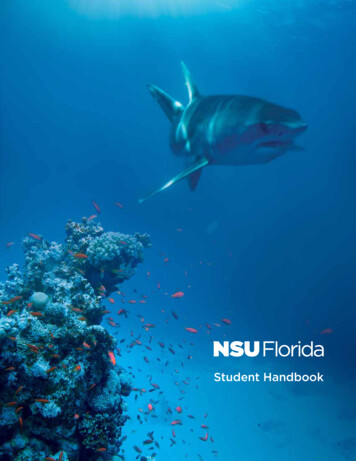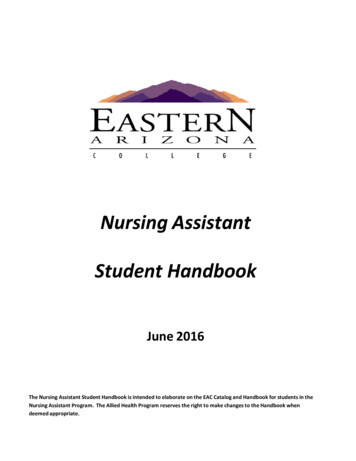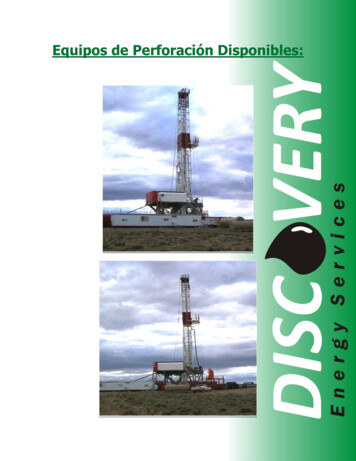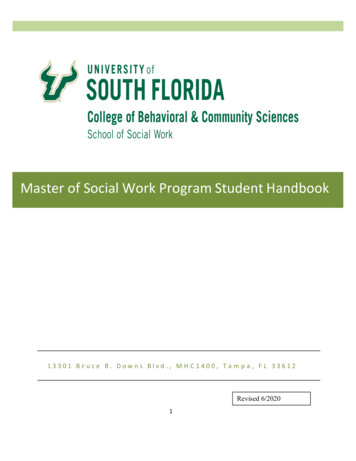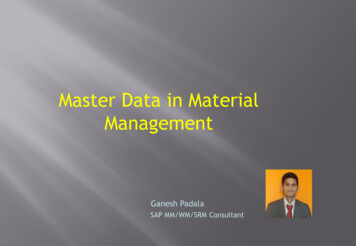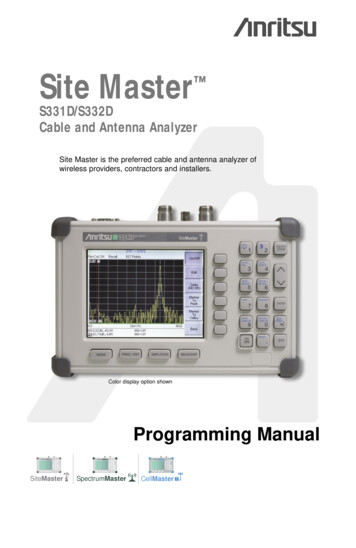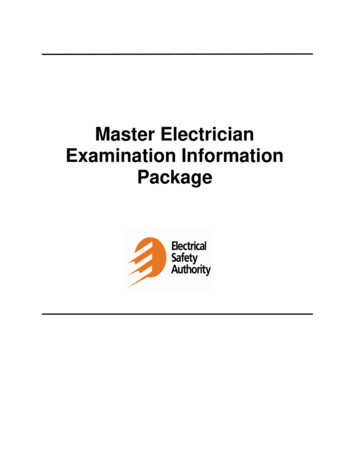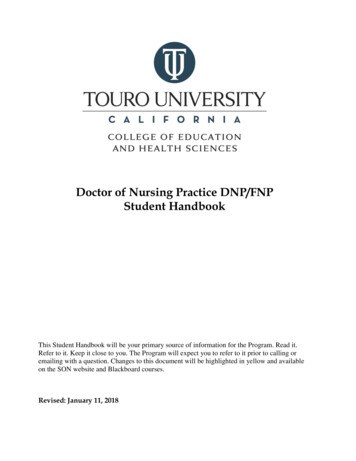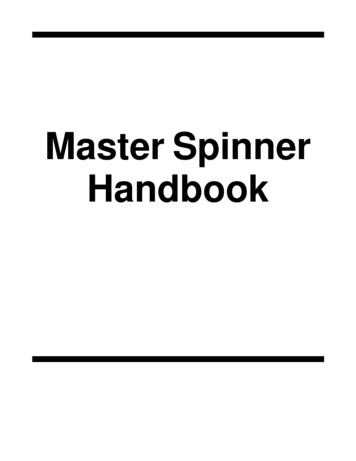
Transcription
Master SpinnerHandbook
Content in this document is current as of time of printing. Check the Master Spinner website for anyrecent changes
Table of uing-education/fibre-artsAdministrative Information1.Master Spinners Program Introduction and Policies .42.Frequently Asked Questions .83.APA Format (Formatting and Style Guide Summary) .114.Level 6 In-Depth Study Policy.135.In-Depth Study Permission and License .186.In-Depth Study Proposal Submission Form .197.In-Depth Study Guidelines .208.Levels 1-6 Competency Profiles .23Technical Information8.Twist Per Inch . 319.Count .3510.Review of Spinning Techniques .4011.Metric/Imperial Conversion Charts.42
Master Spinner Certificate ProgramThe Olds College Master Spinner Certificate Program consists of six progressive levels of classroom andindependent study. These six levels involve skill development, research studies, and project assignments in thearea of hand spinning of all major types of fibres, yarns, and the end-use of the spun yarns.Workshops for levels 1-6 (30 hours each) and level 6 (42 hours) are followed by an independent home studyportion for those students working towards certification. This home study portion will require 125-175 hoursof work for levels 1-5 and an In-Depth study for level 6.A Self-Directed option for experienced spinners is currently available for Levels 1 and 2 (see page 8).At all levels, students are evaluated on the basis of written assignments, practical projects, oral presentations,and skill development.Those individuals who successfully complete the assignments in all six levels will receive a Master SpinnerCertificate from Olds College. See Level 6 In-Depth Study policy for additional details.Electronic SpinnersOlds College is aware that electronic spinners have become more and more popular, and we understand thatsome of our Master Spinner students may be using them when completing their homework. However, for allofferings of the Master Spinner program (both on and off the Olds College campus), manually operatedspinning wheels are mandatory in the classroom, unless the student has been given prior permission to use anelectronic spinner by the Program Manager. Successful completion of the program relies on an understandingof manual spinning wheel mechanics and the ratios used to achieve specific TPI. Our instructors need to beable to see the student’s spinning ability on a manual spinning wheel during the scheduled class time.Master Spinner Program Student PoliciesAudit StudentsStudents may opt to audit a class to upgrade their skills without obtaining a grade when they register for thecourse. They will participate in the workshop only, and will not be required to submit assignments. Thesestudents will receive an audit (AU) designation rather than a percentage grade, and will not be eligible for theMaster Spinner certificate. There is no difference in fees between audit and certificate students.Certificate StudentsStudents who enroll in the Master Spinner courses will be considered successful for each level uponcompletion of the workshop and homework with a passing grade (50%). All assignments will be marked andhave a percentage grade assigned. Upon completion of the requirements of all six levels in the program,students will earn the Master Spinner certificate.Students who do not complete the requirements of the course within the time allotted (see page 6) will notreceive recognition for the course.4
Changing From Audit to CertificationOnce a student has received an audit (AU) designation, if they wish to be eligible for the Master Spinnercertificate, they must re-take the course and complete the homework for a grade.PrerequisitesEach Master Spinner level is a prerequisite for the subsequent level. For example, if a student wishes to enroll ina Level 2 course they must have completed a classroom session of level 1 (or a self-directed option has beencompleted).Student FeesCourse registration and materials fees will be established by Olds College and will be subject to periodicreview. Check the website for the most current information.Students will generally encounter costs in these areas: Course Registration Fees (including marking fee) Materials Fees Personal Classroom Supplies Workbook Assignment Supplies Assignment Mailing CostsCourse Registration FeesClassroom and self-directed fees will be set by Olds College at the time advertising is prepared. These feeswill include the course manual and marking fees.Marking FeesIn the past, students have paid marking fees separately from their registration fees. To minimize the number oftransactions a student will have to make and ensure that they are not subject to the fluctuating fee costs, markingfees are now integrated into the course tuition and payable upon registration in the course.Materials FeesThe instructor will supply many of the fibre materials (other than those on a student supply list) that arerequired for successful participation during a class. The fee for these materials will be collected at the time ofregistration.Personal Classroom SuppliesThe student is expected to come prepared with certain equipment and supplies necessary for successfulparticipation in the classroom activities. The supply list will be provided to all registrants and will also beavailable on the website.Workbook Assignment SuppliesStudents are responsible for procuring fibres and other supplies needed to complete the workbook requirements.These can be purchased from vendors during Fibre Week or from other sources available to them. Theclassroom instructor may have a suggested list.5
Assignment Mailing CostsUpon completion of a homework assignment, the student will mail the project to their assigned instructor.Students are responsible for return mailing costs and should include a cheque payable to the marker for anamount equal to the cost of mailing to that instructor. If the student requires additional mailing information fortheir assigned instructor, they should contact the Continuing Education department at Olds College atconed@oldscollege.ca.Student AssignmentsStudents who are working towards certification will complete a major homework assignment following eachlevel of instruction according to the guidelines presented.Unless otherwise requested or designated, the assignment will be marked by the instructor who taught thatstudent.Assignment TimelinesAssignments must be submitted for marking within 12 months after the class has ended. If the work has notbeen submitted by this deadline, the student will not receive a grade for the course.An extension to this deadline can be requested from Olds College Continuing Education by filling out theHomework Extension Request form found on the website. This request must be received at least one monthbefore the due date. A processing fee will be applied. If granted, the extension will not exceed four monthsbeyond the original completion date. Only one extension date will be allowed per course level.6
Self-Directed LearningThis option is currently available for Levels 1 and 2.An experienced spinner who wishes to enter the program without attending a class may contact the programcoordinator and register for the self-directed option.Completion timelines will be the same as for a classroom course and submissions must be submitted before thedeadline before the student enters the next level.When a student registers for the self-directed option, Continuing Education will:-assign an instructor to that student;-give the instructor’s contact information to the student;-give the student’s contact information to the instructor.The student will receive:-the current course materials;-the current assignment requirements;-up to 3 hours of instructor time (logged by the instructor).The instructor will contact the student by email to arrange a suitable time for an orientation session in order toreview the assignment requirements.The student will be able to address questions to the instructor at such times and in a manner agreed to during theorientation session.When completed, the assignment will be mailed to the instructor for evaluation.7
Frequently Asked QuestionsThis document is designed to answer many of the questions students (both classroom and distance learning) askabout the “processes” of the Master Spinner program. Questions about the content of the various levels and thespecific workbook requirements are best answered by contacting the assigned instructor.How do I set up my workbook?The workbook(s) need to contain all of the exercises listed in the workbook requirements and should beorganized so that an instructor can find the needed materials. Many students submit their work in athree- ring binder(s) using plastic page protectors to hold the skeins and samples. But for ease ofshipping or personal preference, students are free to use file folders, storage boxes, or whatever systemworks for them – as long as it is organized and contents clearly labeled. If in doubt, contact theinstructor to discuss possibilities.All skeins (and samples, if loose) should be properly labeled, as described in the requirements. Skeinsneed to be taken out for examination, so they should not be permanently mounted in the workbook.Place the skeins into the plastic sleeve or folder being used. Proper labels will allow the skeins to bereplaced in the correct location should they accidentally come out.When using tape or glue to secure skeins or samples to a page, remember that when a binder or box isclosed the pages may press against one another. Anything sticky will adhere to facing pages and aninstructor may literally have to destroy a page or pages to remove a skein for examination.I have a physical disability/limitation that makes it impossible for me to do one or more of theexercises needed for the workbook.Most exercises allow for more than one method to be used. For example, if a student cannot use handcards he/she could use a drum carder or flick cards instead. For those exercises that ask for a specifictechnique, the student has the option of attempting the exercise and accepting a lower mark or of notsubmitting the exercise and receiving no mark for it. Students are encouraged to discuss their limitationswith their instructor and see if other options are available.How do I submit my workbook for marking?Contact your instructor for directions on how to send the workbook to her/him. Generally, books aremailed to the instructor, although the instructor may accept written work electronically. The instructorthen marks the book and returns it to the student along with the evaluation sheet(s) and the final markfor the level. Copies of the evaluation sheets and the final mark are submitted to Olds College forrecording.8
If you no longer have contact information for your instructor, contact the Olds College ContinuingEducation Office at 403-556-4740 or by email at coned@oldscollege.ca.How is my work evaluated, and how is my final mark determined?A point value is assigned to each exercise in the workbook requirements and listed in the instructions. Astudent is assessed on how he/she has completed the assignment and a mark is given to it. Classroomstudents are also given a test and the results of it assigned a mark. The marks for the workbook and theclassroom test are totaled and a percentage determined. NOTE: Distance learning students do not haveto do a classroom test. Marks for a test are not included in determining their final mark. By adding upthe marks for the individual exercises, students can determine the total marks available for theworkbook.I find the instructions for some of the exercises vague – why can they not be more specific?Some exercises ask for specific tasks. Others are deliberately vague. Different students may havedifferent approaches to completing a task and there is usually more than one way to accomplish what isbeing asked for. Students are encouraged to think about what needs to be done and how they best see itbeing accomplished. Creativity and independent thinking are encouraged. If one really cannot come upwith a solution contact the instructor for help.Why do I need to use references?Any material you use in your workbooks that is not your own should be acknowledged. Credit must begiven to the original source. Used appropriately, references will show that you have studied the task athand and have selected certain materials to emphasize the points you are making. Failure to creditreferences and attempting to pass off the material as your own original work could lead to charges ofplagiarism.I am not comfortable with my instructor – is there anything I can do?Whether it be a personality conflict or a difference in teaching/learning styles, there may be times whena student and instructor do not get along. If attempts to resolve the issues do not work, a student has theoption of asking the program manager for another instructor. Another instructor may not be possible forthe duration of a class but a different instructor could be assigned to mark the workbook. Similarly,distance learning students who are unhappy with the advice they are being given can request a differentmentor.Why should I bother filling in the evaluation forms?Input from current students is always important. Evaluation forms are looked at and notes made of thecomments. The more people who comment on an issue, the more likely a change will be made. Ifsomething is really bothering you, do not just say “this exercise is a total waste of time” or “this9
instructor is lousy”. Be specific – what is it that has you upset and what do you see as a solution to yourconcern. Well thought out comments will be far more effective at resolving an issue than an angrydiatribe.Praise for what you think are highlights of a course is also important. Knowing what works (certaincourse material, the instructor, and the facility) enables the Program Manager and the instructors tofurther improve the program. Any suggestions for additions and/or deletions to the courses are alsowelcome.I will not be able to finish my workbook before the deadline. Is it possible to ask for an extension?You may request an extension by completing the Homework Extension Request form on the Olds CollegeContinuing Education website under Fibre. The request for an extension must be made at least a monthprior to the current deadline date. Someone from Continuing Education will inform both you and yourinstructor if and when the extension has been granted and what the new deadline is.An extension fee will be administered to process the request.Students who do not complete their work by the new deadline will not have their work marked or a gradeassigned. In order to obtain the Master Spinner certificate, you will need to successfully complete andachieve a passing grade for all six of the Master Spinner levels.I want to dispute the mark that I was given by my instructor. What can I do?The first step in any concern or dispute between a student and an instructor regarding their mark on asubstantive assignment (such as the Master Spinner homework), is to have the student and instructordiscuss the issue. It is always the first step and the most sincere hope of the College that between thestudent and the instructor the issue can be resolved. Students with concerns should reach out to theirinstructor so that they can receive additional insight into their mark.If a student is still unhappy with their mark after reaching out to their instructor and taking his/herfeedback into consideration, then the next and final option available will be to have it re-marked byanother instructor after the student has had an opportunity to update it. This option provides the studentwith 4 months to make improvements on the assignment areas that their instructor has providedfeedback and then resubmit the work to Olds College. Another instructor will be assigned to remark thework. There are additional costs involved to pay for the second marker and associated administrationactivities. It is expected that the student will use the four months to take the feedback into account andupdate their work. This process is available on a case by case basis, and the student should contact theProgram Manager for more information.10
Formatting and Style Guidelines SummaryAny written work that is to be submitted for marking should follow the American Psychological Association(APA) standards. Any written work should be typed and double spaced.All work presented in your assignments must be properly researched and provided with correct citations. Properreferences and citations give credit for other people’s ideas and provide the reader with the sources of theinformation used in the paper.The citation and referencing system used by Olds College is the American Psychological Association (APA)Formatting and Style Guide.This appendix provides a brief summary of the expected citation and referencing styles you should use in yourassignments (further information can be found on various websites).Citations In-Text Citations: When direct quotes are used within the text, the citation source (which includes theauthor, date, and page number) must be provided. For example: “If the project calls for knitting yarn it isbest to aim at an almost balanced yarn as a very unbalanced yarn can cause the knitting to skew to oneside” (Field, 1995, p. 27). Citations of Summaries or Paraphrases: When summarizing or paraphrasing information, the sourcemust be provided. For example: According to Field (1995), balanced yarn should be used for a knittedgarment.A complete reference must appear in the reference list at the end of the paper, for both in-text citations andsummaries.ReferencesA reference list should be provided at the end of the paper that gives the details needed to retrieve the source ofthe information used in the paper. The reference list should be put in alphabetical order, using the authors' lastnames. The following examples show the general format used for different sources of information.BooksAuthor surname, First Initial. Second Initial. (Year of publication). Book title: Subtitle. Place of Publication:Publisher.Fournier, N., & Fournier, J. (1995). In sheep’s clothing. Loveland, CO: Interweave Press.11
Journal or Magazine ArticleAuthor Surname, First Initial. Second Initial. (Year). Article title: Subtitle. Journal Title, Volume (issue),page range.Buchanan. R. (1999, Fall). Evaluating fibre diameter. Spin Off, pp. 23-24.Web SitesAuthor or Corporate Body. (Last update or copyright date; if not known, put n.d.).Title of specific document. Place of Publication: Name of Corporate Body or Publisher.(Do not repeat Corporate Body name if listed above.) Retrieved date the site wasaccessed from URL of specific document.US Department of Agriculture. (1968). United States standards for gradesof wool. Retrieved October 15, 2008, from: http://www.ams.usda.gov/AMSv1.0/getfile?dDocName STELDEV3062803 .University of Kentucky, College of Agriculture. (n.d.). No article name. RetrievedNovember 3, 2008, from: http://www.uky.edu/Ag/AnimalSciences/index.html.12
Level 6 In-Depth Study PolicyPREAMBLEThe final assignment for successful completion of the Master Spinner certificate is an in-depth study selectedand completed by the student on an aspect of hand spinning. Completed studies are available for viewing onthe Olds College website. These can be found by the following steps:Go to www.oldscollege.caClick on Learning CommonsClick on LibraryClick on Research GuidesClick on Library and Research HelpClick on Master Weaver and SpinnersCHOOSING A STUDY TOPICStudents choose their own in-depth study topics. However, the study topic should fall into one of the followingtwo categories: Experiment or Research.Experiment studies include some form of measurement and/or ranking of samples. Students could choose toexplore yarn construction or fibre type related to suitable end uses, evaluate aspects of hand spinningtechniques or hand-spun yarns using various measures, or attempt to prove or disprove a commonly acceptedrule, for example. All Experiment studies include measurements, either quantitative, qualitative, or both.1Research studies focus on a particular topic and explore it in detail. Students could choose to research aspecific fibre type, answer a question about an aspect of hand spinning, or look into the history of a fibre artspractice or culture as it relates to spinning, for example. Research studies do not always include measurements,but should include some evaluation by the student to answer the proposed question.Study topics must be unique to the Olds College Master Spinner program.2 Students can choose to buildon the work of an existing study, provided that the new study adds to the knowledge contained in theoriginal.3Study topics must be broad enough to spin a minimum of 10 and a maximum of 25 skeins of yarn. Each yarnmust also be made into a minimum of one and a maximum of four fabric or end-use samples at least 10 cm/4”square. Study topics must also allow for additional research, with a minimum of seven references in thebibliography (no maximum).13
PROPOSING A STUDY TOPIC Students must be currently enrolled in Level 6 of the program to submitan in-depth study proposal. They must also have completed and submitted their Level 5 workbook. The latesta student can submit a study topic for approval is four months following their Level 6 class.To submit an in-depth study proposal, students must fill out the online form located ams/con-ed/fibre/master-spinner/Master-Spinner Indepth.pdf The form asks the student the following: Student contact information Draft title of study Type of study (Experiment/Research) Paragraph explaining the proposed topic, including hypothesis/purpose statement, fibre type(s),preparation method(s), spinning method(s), and type(s) of samples. Finishing method(s) can be included, ifapplicable Number of skeins proposed (10-25) Number of samples per skein (1-4)All fields are required. The completed form will be sent to the assigned Level 6 instructor for that year.4 TheLevel 6 instructor will evaluate the proposal and contact the student if s/he has any concerns or suggestions.Once any concerns or suggestions have been incorporated into the study proposal, the Level 6 instructor willinform both the student and the Fibre Arts Programmer that the study topic has been approved. The finalproposal will be kept in the student’s file at Olds College.All studies will be graded on how well they fulfil the proposed topic of study. In some cases, students may wishto make changes or adjustments to their study as they work through the process. If there are any materialchanges to the number or make-up of skeins, number or make-up of samples, or purpose statement of thestudy after it has been approved, these changes must be submitted to the Level 6 instructor beforeproceeding. As much as possible, the instructor will give due consideration and approve any adjustments,provided that they do not significantly change the expected research outcomes of the study or exceed theminimum/maximum number of skeins or samples.1Quantitative data can be exactly measured, for example surface area, breaking point, and twists per inch. Qualitative data is lessexact and more about the experience of the evaluator, for example hand, stitch definition, and drape. 2 Topics that have been exploredthrough work at other institutions or in published books are available to Master Spinner students, provided that a similar study has notbeen conducted by previous Master Spinner students at Olds College. 3 Some previously completed studies relate to dye processes. Thesestudies are not eligible for expansion work. Only studies related to spinning alone can be built upon.14
STUDY FORMAT An in-depth study is an academic report. As such, it must conform to the requirements forreports set out in the current American Psychological Association (APA) style guide for citations, line spacing,margins, headers, page numbers, title page, abstract, tables of contents and figures, and bibliography. If youhave any questions, please contact your instructor or refer to this page: https://www.oldscollege.ca/studentlife/learning- commons/library/copyright/index.html.The final copy of the report will be scanned and added to the online library on the Olds College website.Following scanning it will be returned to the student (Olds College will pay for returning the copy).4If the Level 6 instructor has a conflict of interest with regards to a student, s/he will inform the Fibre Arts Programmer, whowill assign another instructor to grade that students work.The written report must follow the structure below:1. Title Page: contains the title of the report, your name, the words “submitted to Olds College” and thedate the report was submitted (see below). Running head as per APA style guide is required.2. Abstract: a one-page summary of the study, including hypothesis/purpose statement, brief summary ofexperiment/research, and conclusions. The abstract is written after the rest of the report is completed.3. Table of Contents: lists, in order, the sections of the report and the pages they begin on. If needed,include a Table of Figures and/or Table of Tables following the Table of Contents.4. Introduction: discuss the purpose of the study, the scope of the experiment/research, and any limitingfactors. This section should also include a review of existing information from various sources.5. Materials and Methods: describe how you conducted the study, the materials and techniques used andreasons for those choices, and how data was collected and analyzed.6. Results: detail your findings. For experiment studies, this should include tables of data and any ways inwhich you manipulated the data to examine different aspects of the initial question. For research studies,this should include any observations you made during spinning that relate to your purpose statement.7. Conclusion: analyze your results and form conclusions. Include at least three recommendations forfurther study.8. Bibliography: a properly formatted list of all works cited in the study.9. Appendices: any data that should be included in the study but would disrupt the flow of the report ifincluded in the above sections. These might include skeins and samples, detailed descriptions of methods,complete skein information as required by the Master Spinner program, full charts of results, and/orphotographs, among others.Using the above format, students can generate a plan to approach their study topic. Writing an initial draft ofthe Introduction and Materials and Methods sections prior to beginning any spinning will allow the student todiscover what information already exists and write out a plan to proceed with their experiment or research. Thisdraft can then be edited upon completion of the study for the final report.15
Organization and good record keeping are the major elements of a successful study. Students should alwayskeep their proposal in mind as they proceed, and ensure that their work remains relevant to fulfilling it. Thesequestions can help guide students through their study and remain focused: What is the question I am studying? What do I have to do to find the answers? What is a manageable scope for this study and what limits can I impose on the question to keep the workmanageable? What research do I need to complete before beginning to prepare fibre/spin? What kind of notes do I have to keep while I am preparing fibre/spinning/creating samples so that Ican include all the appropriate information in my final report? What kind of fibre samples are important to include in my report (prepared fibre, singles, yarn,cloth/end use samples)? Am I going to include full skeins in my final report or only small yarn samples and send the skeinsseparately? Am I going to create a copy of the study for myself?COMPLETION DEADLINES Students who have submitted a proposal and had it approved must be enrolledin a Level 6 class. If circumstance prevent the student from taking the class, students may request a one-time,one- year deferral by completing the extension request form on the Olds College, Continuing Education website.If there are not enough registered students to run a Level 6 class, all outstanding students automatically receive adeferral to the following year.In-depth studies must be completed within one year of taking the Level 6 class, unless the student requests anextension. Extensions must be requested a minimum of one month before the completion deadline. Extensionsprovide the student an additional four months to complete the work, and only one will be granted. Anyapproved extension will require the payment of an ext
Once a student has received an audit (AU) designation, if they wish to be eligible for the Master Spinner certificate, they must re-take the course and complete the homework for a grade. Prerequisites Each Master Spinner level is a prerequisite for the subsequent level. For e
